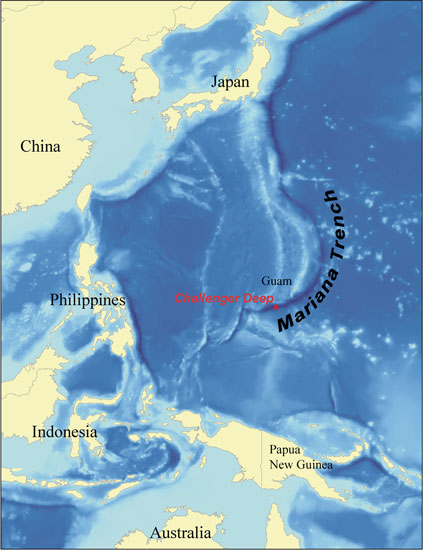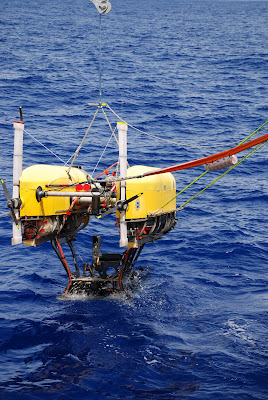The luck charm must have still worked, however, because not long thereafter I got an e-mail from Dr. Shank asking me to accompany him on a research cruise to the Challenger Deep in the Mariana Trench (the deepest point in the ocean)! The trip included about two weeks at sea, three weeks total travel time. We left from Guam. Wow.
Where is the trench, anyway?
 From www.whoi.edu
From www.whoi.eduA Science Cruise
When scientists talk about cruises, it’s really hard to imagine what they are talking about. Many people come up with images of Carnival Cruise Lines, pool boys, and drinks adorned with little umbrellas. Around the lab, when you say “I’m going on a cruise,” different images come to mind.
For me, a cruise means really cool science. I’ve always wanted to go on a cruise. I think of deep submersibles traveling to the ocean’s depths and bringing back presents for us scientists—be they water samples, rocks or mud, or as is the case for me and my fellow biologists, little critters that we would never see or touch were it not for the technology that takes us out to sea.
For many who do coastal work, getting samples is relatively straightforward, at least as far as geography goes. For those of us who work on deep-sea habitats like hydrothermal vents (basically hot springs at the bottom of the ocean) or seamounts (similar to mountains or volcanoes on land, only underwater), it’s really hard to get animals to study. That’s where the technology comes in.
In addition to the work and the science, you still get the amazing vistas that you might imagine on any type of cruise.
Sunrise at Sea:

Sunset at Sea:

HROV Nereus
This particular cruise was the final test cruise for WHOI’s new deep submersible Nereus, which is a Hybrid Remotely Operated Vehicle (HROV). That means that it can be either a remotely operated vehicle (ROV)—tethered to the ship and controlled by a team in real-time—or an Autonomous Underwater Vehicle (AUV). AUVs are preprogrammed with a mission and sent out to complete that mission free from human contact until retrieved and the data collected. Nereus wears both hats, which is why we call it a hybrid.
I witnessed the culmination of many years of work on the part of an all-star engineering and design team from WHOI and Johns Hopkins University. Because of these masterminds, US scientists now have the ability to work at the deepest parts of the ocean. I am extremely lucky to have been on such a historic cruise and was perpetually awed by the sheer brainpower aboard the ship!
I was part of the science team on the ship (consisting of Dr. Tim Shank and myself from WHOI, and Dr. Patricia Fryer and Sam Hulme from the University of Hawaii) and I helped Tim to preserve and catalog the biological specimens we pulled up with Nereus.
HROV is designed to travel to the deepest regions of the ocean and to withstand pressure too intense for other submersibles. It allows us to stay at depths of approximately 11 km (deeper than Mount Everest is tall) for many hours to explore and collect scientific samples.
For more information about the vehicle, please visit WHOI’s Nereus website. You can also visit the press release for the cruise.
Nereus and me on the back deck:

My Graduation
The only slight hesitation I had when responding to Tim’s invitation was that I’d miss my college graduation. That only detained me for a few minutes because it occurred to me that the life-long dream of going to sea for science research was WAY cooler than staying for commencement. So I said bye to my friends early and headed off to Guam.
The day of my commencement back in Ohio, however, some of the other scientists on the cruise surprised me with a shipboard graduation ceremony. It was extremely sweet and funny and I was truly surprised. Everyone dressed up in “robes” that were really garbage bag capes and mortarboards that were made out of cardboard boxes. The tassels were made out of thick twine. There were mini-speeches and everything!
Firsts
I could go on and on and on about his trip—my first cruise, my first real-time observation of a hydrothermal vent, my first time snorkeling (I know, I know, how had a marine biologist not snorkeled? I’m from Seattle and went to school in Ohio!). I think I was also the first person to have a fake graduation ceremony on the RV Kilo Moana (the University of Hawaii's research ship that took us out to the trench).
This trip won my “most amazing scientific experience ever” prize and is an opportunity that I wouldn’t have had if I hadn’t been in exactly the right place at the right time. The people who work at WHOI's Deep Submergence Lab do incredible work and I am so honored to have been included on this cruise! One of my favorite things about WHOI is the high level of interdisciplinary collaboration and this trip is an excellent example of how scientists work with engineers to explore the ocean and push the boundaries of ocean science.
Neat picture of HROV going into the water:

More to come!
-Ellie
***All photos By Ellie Bors, Woods Hole Oceanographic Institution
No comments:
Post a Comment